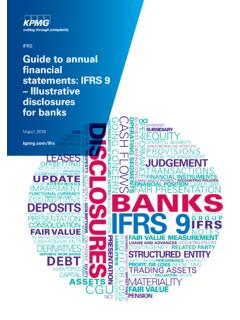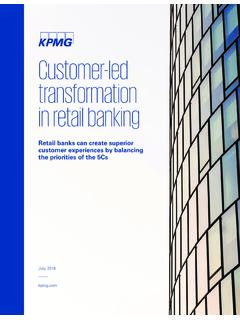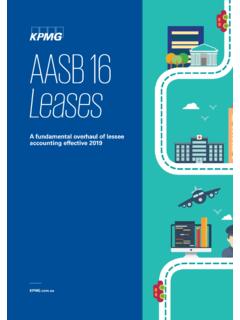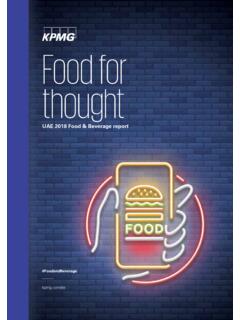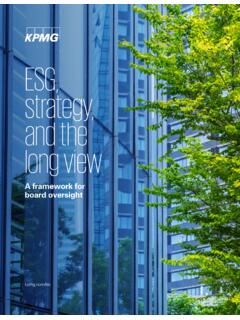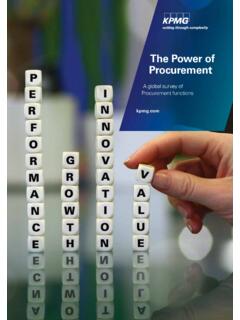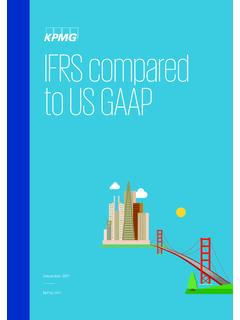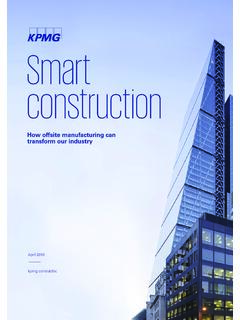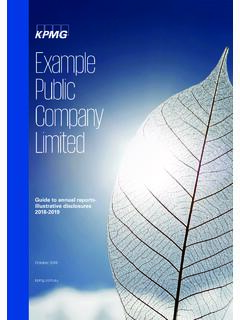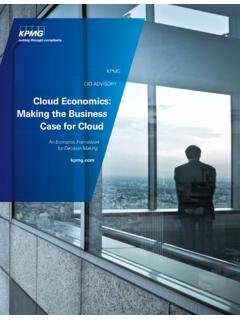Transcription of The 14th Five-Year Plan: Sector Impact Outlook
1 The 14th Five-Year plan : Sector Impact Outlook KPMG ChinaFebruary 2021 KPMG Advisory (China) Limited, a limited liability company in China and a member firm of the KPMG global organisation of independent member firms affiliated with KPMG International Limited , a private English company limited by guarantee. All rightsreserved. China s new development path under the 14th FYP2021 sees the start of China s 14th Five-Year plan ( 14th FYP), particularly noteworthy as it charts the first five years of China's new journey towards fully building a modern socialist country and achieving its second centennial goals. These five years also constitute a critical period of strategic opportunities for China to explore and experiment with new models of development amid significant changes inside and outside the for the Two CentennialsSource:Governmentreports,KPMG analysis1921194920252035 Goals for the Second Centennial2049 Goals for the First CentennialFinal year of the 14th FYPR ealisation of socialist modernisationAchieved goals in terms of a strong, modern, culturally advanced and socialist societyFounding of the Communist Party of ChinaCompletion of building a moderately prosperous society Founding of the People s Republic of ChinaIn October 2020, the fifth plenary session of the 19th Central Committee of the Communist Party of China passed the Recommendations for the Formulation of the 14th Five-Year plan (2021-2025) for National Economic and Social Development and the Long-Range Objectives Through the year 2035 (the Recommendations) to guide development under the 2021 KPMG Advisory (China)
2 Limited, a limited liability company in China and a member firm of the KPMG global organisation of independent member firms affiliated with KPMG International Limited , a private English company limited by guarantee. All rightsreserved. The Recommendations describe three new dimensions of development: a new development stage, a new development philosophy and a new development :Governmentreports,KPMG analysisChina s internal and external environment is going through high-speed development model is transitioning towards a high-quality modelNew development stageThe new development philosophy is characterised by innovation, coordination, environmental protection, openness and new development strategy features internal circulation as the mainstay, with external and internal circulations reinforcing each China envisions is not a development loop behind closed doors, but instead more open internal and external circulations. Promoting smooth, large-scale internal circulation will help better attract global development strategyNew development philosophyDuring the 14th FYP period, China will continue to shift its focus from rapid economic growth towards optimising the country s overall economic structure and improving people s living standards.
3 With these objectives in mind, China will focus on enhancing the quality and efficiency of its 14th FYP period is a decisive stage in China s transformation, as the country transitions from a moderately prosperous society into a modern socialist country. With China shifting its focus to high-quality development, the various sectors of the economy are expected to upgrade and change significantly as more challenges and opportunities arise. In the sections below, we describe the changes and opportunities that the Recommendations will bring to 10 sectors: asset management, auto, banking, energy, healthcare and life sciences, industrial manufacturing, insurance, technology, real estate and three key features of the 14th FYPS ource:Governmentreports,Wind, FYP1991-19959th FYP1996-200010th FYP2001-200511th FYP2006-201012th FYP2011-201513th FYP2016-202014th FYP (est)2021-2025 GoalsActualFigure3 Targeted and actual GDP growth rates for various FYP periods (%)Unlike the previous FYPs, the economic development goals set out in the Recommendations from the 14th FYP period to 2035 are expressed in both qualitative and quantitative terms.
4 According to these goals, China s economy is expected to maintain average growth of over the next five years and meet the current standards for high-income countries by the end of the 14th FYP period. We estimate that China will sustain average growth of during the 14th FYP period, well above this target. 2021 KPMG Advisory (China) Limited, a limited liability company in China and a member firm of the KPMG global organisation of independent member firms affiliated with KPMG International Limited , a private English company limited by guarantee. All rightsreserved. 301 One of the main themes of the 14th FYP is the continued reform and opening-up of the financial Sector . The Recommendations include several plans for this Sector . In fact, the word financial is mentioned 16 times in these documents. In view of the banking Sector s current dominance in China s financial system, the Recommendations put forward goals that include the further reform of state-owned commercial banks, the sustainable and healthy development of small and medium-sized banks and rural credit cooperatives, and the reform and optimisation of policy-based financing.
5 The Recommendations also call for the steady advancement of market-oriented interest rate reforms and more efficient allocation of resources in the financial system. During the 14th FYP period, we believe that the banking Sector should focus on supporting and serving the real economy, developing a digital currency and strengthening the financial regulatory on better serving and supporting the real economy01 Consolidation of resources to help small to medium-sized banks strengthen their risk capabilities02 Continuous promotion of pilot testing for the e-CNY, China s Central Bank Digital Currency (CBDC)03 Modernisation of the financial regulatory system 04 Key trendsFigure 4 Inclusive bank loans to micro and small enterprises, RMB billion Source:Wind,KPMG analysis02,0004,0006,0008,00010,00012,00 014,00016,0002019-032019-062019-092019-1 22020-032020-062020-09 Large commercial banksShareholding commercial banksCity commercial banksRural financial institutionsSupporting the real economy and mitigating risks Banking 2021 KPMG Advisory (China) Limited, a limited liability company in China and a member firm of the KPMG global organisation of independent member firms affiliated with KPMG International Limited , a private English company limited by guarantee.
6 All rightsreserved. 402 The new Dual Circulation development strategy places the domestic market as the mainstay for China's future growth, which makes indigenous innovation even more critical. In order to successfully upgrade, enterprises in the relevant industries need to operate in a multi-level investment and financing system. For this reason, during the 14th FYP period, capital markets should focus on the reform and opening-up of the capital market and the optimisation of corporate financing in the share of direct financing in the economy01 Promotion of the opening-up of capital markets and RMB internationalisation02 Diversification of household wealth allocation 03 Promotion of green finance to support sustainable development04 Use of technology to empower the asset management industry05 Key trendsFigure 5 The share of equity and bond funding in China s total new financing5%3%4%8%9%11%13%11%12%14%16%12% 17%24%24%6%13%14%0%5%10%15%20%25%30%2002 20042006200820102012201420162018 Source:Wind,KPMG analysisFigure 6 RMB financial assets held by overseas investors, RMB billionSource.
7 Wind,KPMG analysis01,0002,0003,0004,00020132014201 52016201720182019 BondsStocksLoansDepositsDeepening the reform and opening-up of capital markets, and optimising financing structures and household investment portfolios Asset management 2021 KPMG Advisory (China) Limited, a limited liability company in China and a member firm of the KPMG global organisation of independent member firms affiliated with KPMG International Limited , a private English company limited by guarantee. All rightsreserved. 503 Mentioning insurance nearly 15 times, the Recommendationsdiscuss the future of multiple insurance sub-sectors, including long-term care insurance, commercial medical insurance, agricultural insurance, natural disaster insurance, critical illness medical insurance, basic medical insurance, basic pension insurance, unemployment insurance, work-related injury insurance, deposit insurance, public service platforms for social insurance, and the three-pillarpension insurance system in China.
8 These insurance sub-sectors will become key drivers for industry as it further develops. Going forward, insurance providers are expected towork to improve the services and plans they offer, directly impacting people s livelihoods, economic development and society as a 7 Market penetration of first-, second-, and third-pillar1pensioninsurance in China compared to the US, 2018 Source: China Merchants Bank , KPMG pillarSecond pillarThird pillarUSChinaFigure 8 Health insurance premiums in China, RMB billionSource:Wind,KPMG analysis01002003004005006007008009002012 20132014201520162017201820192020 Accelerating the development of personal commercial pensions into a main driver to improve society and people s livelihoodsInsuranceAccelerated development of commercial insurance as the third pillar of the pension system 01 Fast-growing and more diversified demand for health insurance 02 Continuous development of agricultural insurance to promote social inclusiveness03 Addressing gaps in catastrophe risk protection 04 Key trends1 Three pillars refer to government scheme, enterprise/occupational annuities, and private pensions for individuals respectively.
9 (Source: China pensions landscape the year in review and what s ahead, March 2019, KPMG China ) 2021 KPMG Advisory (China) Limited, a limited liability company in China and a member firm of the KPMG global organisation of independent member firms affiliated with KPMG International Limited , a private English company limited by guarantee. All rightsreserved. 6604 China s consumer market has experienced a sustained post-pandemic recovery. The recovery was initially driven by manufacturing and production, investment and exports. As the economy continues to recover, consumption and service industries will play a more pivotal Recommendations call for the stimulation of consumption in all sectors , and focus on how to achieve this goal. Consumer and retail markets are expected to surge rapidly during the 14th FYP period and become a cornerstone of China s economic of indigenous Chinese brands01 Booming new consumption patterns such as livestream e-commerce, private domain traffic and duty-free shopping02A large market in lower-tier cities and rural areas03 Local services such as community group shopping will usher in more opportunities04 Key trendsDistribution of interest in Chinese local brands by age groupSource: Baidu, , KPMG analysis01020304050607080 5040-4930-3920-29 19 Age GroupsLevel of interest in 2009 Level of interest in 2019 Figure 9 Consumption has become the cornerstone of China s economy, with new forms of consumption and business models emergingConsumer marketsMarket size and growth of livestream e-commerce, 2017-2021 Source.
10 Live Streaming E-commerce Strides Towards a RMB 1 Trillion Market, KPMG and AliResearch, November 2020 Figure size (RMB billion)Growth rate (%, rhs) 2021 KPMG Advisory (China) Limited, a limited liability company in China and a member firm of the KPMG global organisation of independent member firms affiliated with KPMG International Limited , a private English company limited by guarantee. All rightsreserved. 705 During the 13th FYP period, China promoted supply-side structural reforms to boost production capacity and improve certain industries. As a result, the country s capacity utilisation rate gradually rebounded from a low of in the second quarter of 2016 to 78% by 2020. Going forward, the Recommendations aim to boost the modernisation of industrial chains and supply chains, and maintain a stable proportion of the manufacturing Sector . During the 14th FYP period, we expect China to continue to pursue its main goal of becoming a manufacturing powerhouse, leveraging innovation and connectivity within the manufacturing industry to promote high-quality economic development.
